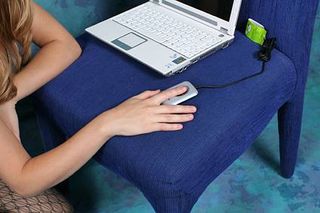Microsoft Fingerprint Reader

We've tested notebook computers with built-in biometric scanners and associated recognition software. We have come to appreciate the added security that a biometric scan can bring to access control. By adding a look at your finger or other body part such scans up the ante from the more typical account/password authentication used on many notebooks.
Security mavens believe that security improves as the number of authentication factors increases, so by adding a fingerprint scan to an account/password login, you've gone from single-factor to dual-factor authentication and thereby greatly lowered the odds of a successful impersonation. Spy novel fans and hobbyist criminologists will quickly think of ways to get around the fingerprint scan, but in the real world forcing its owner to use it on your behalf or obtaining the finger or fingerprint through other means limits the probability of impersonation substantially.
We approached the Microsoft Fingerprint Reader, a USB 2.0 device, with some excitement when we decided to review it for this Holiday Buyers Guide. It's a light, compact device that is 3.23" x 1.97" x 0.60" and weighs only 3.78 oz / 107g - well-suited to make itself at home in a notebook bag without taking up very much space at all, or adding much to the total carrying weight, either.
The Reader works only with Windows XP (Home, Professional, Media Center, and Tablet PC editions). Installing the product took about a minute. As long as you install the driver before plugging in the reader for the first time, it will be recognized immediately. But you must reboot your PC before you can begin to use the device.
After that you go through the process of registering fingerprints. You can then instruct Windows to access the fingerprint reader in lieu of requesting a text password to access password-protected accounts, Web sites, and resources. The MS Fingerprint Reader does not integrate with Active Directory, so you can't use a fingerprint scan in place of entering your domain name, account name and password to log into a domain to which you belong. Thus, the Reader is best used to control access to resources local to your computer. Fast User Switching in Windows also makes it possible to switch between or among multiple user accounts on the same machine using fingerprints, as long as all accounts have associated, registered fingerprints defined for them.
We were unable to find any references to products or situations where the MS Fingerprint Reader is used for multifactor authentication (fingerprint and standard login) and it's too bad the product doesn't work with domain logins. To our way of thinking this makes it a convenient but entirely personal security product best put to protecting what's on a notebook computer. The MS Fingerprint Reader makes a super stocking stuffer for tech-friendly friends and family members.
Stay on the Cutting Edge
Join the experts who read Tom's Hardware for the inside track on enthusiast PC tech news — and have for over 25 years. We'll send breaking news and in-depth reviews of CPUs, GPUs, AI, maker hardware and more straight to your inbox.
Current page: Microsoft Fingerprint Reader
Prev Page Blackberry Pearl PDA Next Page Gateway E-100M LaptopEd Tittel is a long-time IT writer, researcher and consultant, and occasional contributor to Tom’s Hardware. A Windows Insider MVP since 2018, he likes to cover OS-related driver, troubleshooting, and security topics.
Most Popular


